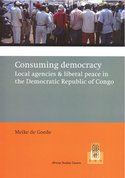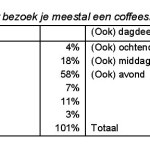Goede, M.de ~ Consuming Democracy: Local Agencies & Liberal Peace In The Democratic Republic Of Congo
No Comments yet This thesis is about democratisation as a central pillar of liberal peace building in the Congo and focuses on Parliament and parliamentarians in this process. The picture above captures many of the themes that will be discussed in the chapters that follow: that of the interaction between Members of Parliament (MPs) and their electorate, the self-perception and popular perception of MPs in the Congo, and the roles of MPs as providers that redistribute. The picture shows a painting made by a popular artist from Kinshasa that criticises MPs and by extension Parliament as an institution. When I bought it the painter explained to me what he intended to express by this image. ‘Kuluna en cravate’ is a reference to MPs used by Kinois and refers to the recent phenomenon of Kuluna, violent and thieving youth gangs. The MP is a Kuluna in a tie (cravate). He gives money to some people. He has three ladies by his side, ‘because he is very rich’, and the media is present to record his well doing and expose the MP as a provider for the people. But the painter also expressed a critical reflection on these practices by mockingly referring to the MP as a Kuluna in a tie. Although the MP appears to do something for the people, he has in fact stolen his wealth from the people and he is acting against them (contre la population congolaise).[i]
This thesis is about democratisation as a central pillar of liberal peace building in the Congo and focuses on Parliament and parliamentarians in this process. The picture above captures many of the themes that will be discussed in the chapters that follow: that of the interaction between Members of Parliament (MPs) and their electorate, the self-perception and popular perception of MPs in the Congo, and the roles of MPs as providers that redistribute. The picture shows a painting made by a popular artist from Kinshasa that criticises MPs and by extension Parliament as an institution. When I bought it the painter explained to me what he intended to express by this image. ‘Kuluna en cravate’ is a reference to MPs used by Kinois and refers to the recent phenomenon of Kuluna, violent and thieving youth gangs. The MP is a Kuluna in a tie (cravate). He gives money to some people. He has three ladies by his side, ‘because he is very rich’, and the media is present to record his well doing and expose the MP as a provider for the people. But the painter also expressed a critical reflection on these practices by mockingly referring to the MP as a Kuluna in a tie. Although the MP appears to do something for the people, he has in fact stolen his wealth from the people and he is acting against them (contre la population congolaise).[i]
Liberal peace building in the Democratic Republic of Congo
Liberal peace building in the Democratic Republic of Congo (DRC, the Congo) started after the signing of the Sun City Peace Agreement (2002). The 2006 general elections marked the end of a transitional period and in November 2011 the Congolese electorate went to the ballot box to elect a President and Parliament for the second time. Until then, results of liberal peace building interventions in the Congo have been disappointing and discouraging. Nearly a decade of peace building has had a limited impact on people’s daily lives. Freedom House consistently ranks the Congo as ‘not free’ with political rights and civil liberties marked six out of seven (one being most free and seven being the most unfree). In 2011, the country was ranked as one of the most corrupt countries in the world and has sunk to the bottom of the Human Development Index.[ii] During the first term of his Presidency, Kabila has firmly established his regime and taken control over the state and its institutions. This has on the one hand brought some stability after the turbulent past decades, while on the other hand it has been cause for concern. People feel that the regime is developing dictatorial tendencies. It swallows all power and leaves little space neither for the opposition nor for state institutions such as the courts or the security forces to be non-partisan. Particularly in the pre-electoral period of 2011 the Kabila regime has shown a concerning side of itself, that of violence, and intimidation, and sometimes magnificent strategies of political and electoral manipulation. Within five years after the celebration of the country’s first elections as the launch of a new democratic era for the country people already speak of a return to ‘Mobutism-without-Mobutu’. The country is as corrupt as ever, the state is malfunctioning and there are little signs of any improvement. The armed forces continue to be a source of insecurity to an already battered population, and poverty and human suffering aggravates instead of reduces. The liberal peace seems to have derailed and lost its momentum, right under the noses of its agents (the donor community, the international community), and with their financial support.
The liberal peace is founded on the idea that liberal market democracy fosters domestic and international peace. Political and economic liberalisation is therefore employed as a means to end and prevent violent conflict (Paris 2004, 40-42). It thus ‘combines and conflates’ democracy with peace. This has resulted in a project of social transformation which aims to transform dysfunctional societies into peaceful societies by including them in the liberal world order (Duffield 2001, 11). This project of social transformation comes in different graduations – conservative, orthodox, emancipatory – reflecting graduations in the balance between coercion, top-down intervention and externalisation on the one hand, and local ownership, bottom-up peace building, consensus and social justice on the other (Richmond 2005, 214-15). Liberal peace building involves democratisation and liberal market reform (Richmond 2006, 292). This thesis is concerned with post-war democratisation in the Congo, as one of the central pillars of liberal peace building. Democratisation in liberal peace building terms prioritises a rights based approach which focuses on elections, the institutions of democratic governance, civil society building, the rule of law, and human rights. This thesis focuses on the Congolese National Parliament as a site of democratisation. Although democratisation as part of liberal peace building in the Congo only started after the signing of the 2002 peace agreement, the efforts for democratisation in the Congo date back more than 20 years. The past two decades have been extremely volatile in the Congo. In the early 1990s Mobutu’s dictatorial regime crumbled and a process of political change towards democracy was launched.
Since then the Congolese population has been awaiting elections, while undergoing various phases of democratisation. They were insecure and turbulent times. The democratic transition of the 1990s failed eventually and was overtaken by a civil war. The first Congolese war (1996-7) had its origins in the disintegration of the Zaïrian state, the genocide in neighbouring Rwanda followed by a security crisis in Zaïre and the inability of the Mobutu regime to respond adequately to these developments. Under these conditions of weakness of the state, the challenges posed by the crisis in neighbouring Rwanda easily spilled over to Zaïre to become a Zaïrian crisis. With support from Rwanda and Uganda, an alliance of four rebellion or opposition parties known as the Alliance des Forces Armées pour la Libération du Congo (AFDL), under the leadership of Laurent-Désiré Kabila, launched a successful war against Mobutu in September 1996, accessing power on May 17 1997. However, it was not long before the Kabila coalition fell apart. In August 1998 a new war was launched by RCD (Rassemblement Congolais pour la Démocratie), a new rebel movement with the support of Rwanda, shortly followed by MLC (Mouvement pour la Libération du Congo), which was supported by Uganda. The Second Congolese war involved many neighbouring countries. While Uganda and Rwanda were fighting on the anti-Kabila front, Angola, Zimbabwe, Namibia and Chad continued to support Kabila. On the side of the resistance another three movements developed in due course: RCD-K/ML (Kisangani/Mouvement de Libération) (also backed by Uganda) and RCD-N (National) split away from what now became known as RCD-Goma. In addition, the Mai Mai, groups of armed fighters that have existed since the 1960s, became involved in the war, as well as various rebel movements from neighbouring countries that were operating from in the Congo. In addition, several African countries sent their armies in support of Kabila’s regime. Within a short period of time, the war had become a complex patchwork of armed rebellions and foreign armies roaming around Congo.
Full text (PDF): https://openaccess.leidenuniv.nl/ASC-075287668-3597-01.pdf?sequence=2
Notes
[i] Author’s conversation with artist, Kinshasa 23 July 2011.
[ii] www.freedomhouse.org; http://cpi.transparency.org/cpi2011; http://hdr.undp.org.
Thesis published in 2015 ~ ISSN: 1876-018x ISBN: 978-94-6173-720-5
You May Also Like
Comments
Leave a Reply







